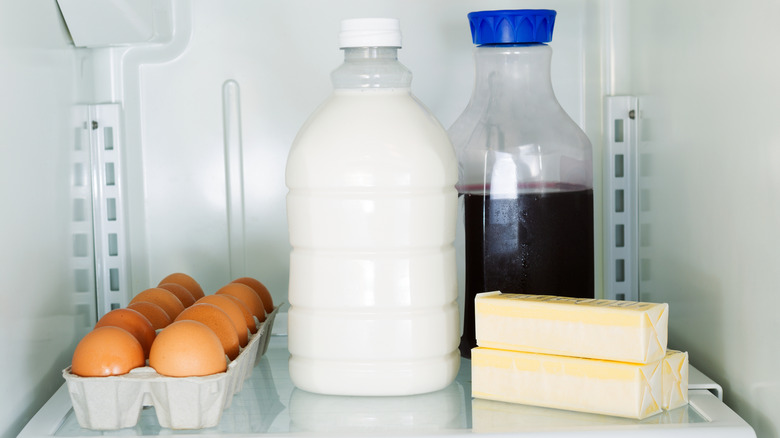According To Land O Lakes, This Is The Best Way To Store Butter
There are acolytes on both sides of the butter storage debate — counter or fridge? Luckily there are no Romeo and Juliet-style fights on this topic, tearing families apart, but it is still important to know what's best. Land O Lakes has weighed in and says that the best way to store butter is in the fridge, no matter what kind of butter you buy.
There is a simple reason why: Butter can spoil. Basically, butter is made up of water, proteins, and fats. At room temperature, the water begins to interact with the fats and degrade them, leading to rancid, flavorless butter. If butter turns from a pale gold color to darker yellow, brown, or pink, it is a sign of spoilage. It might even begin to smell off or change texture.
Even refrigerated butter won't last forever. It maintains its best quality if used within about three months. Land O Lakes recommends you keep the butter in its original wrapping. Plastic wrap, plastic bags, or an airtight butter dish are better for partially used sticks. If you need your butter to last a few months, keep it in its original packaging and place it in the freezer. Properly stored butter will stay fresh in the freezer for four months past the "use by" date. Though it will be safe to use indefinitely, the quality will start to decrease after that point. The butter storage debate will surely rage on, but the food safety-minded will likely continue their refrigerator butter storage unabated.
Getting your butter to the right temperature
Keeping your butter in the fridge full-time has one direct impact on daily use: It means your butter is always cold. Spreading cold butter on toast is not ideal, which is why most restaurants serve butter at room temperature. Fortunately, the experts at Land O Lakes tell us you can leave butter out at room temperature for about four hours.
To safely get your butter up to room temperature, you can do a number of things. If you plan ahead, you can place your butter on a small dish 30 to 60 minutes before use. You can also cut the butter into smaller pieces to speed that process up. The microwave works too if you keep a close eye and use a low power setting, but this might be best for melting butter fully – even 20 seconds can totally liquify it. You can even soften butter with a cheese grater or rolling pin.
While it isn't necessarily recommended according to federal guidelines, some people will risk counter storage to have room temperature butter on hand. If that sounds like you, at least make sure you minimize the risks. First, only attempt to store salted butter at room temperature, as the sodium content acts as a natural preservative. Make sure your kitchen is 70 degrees Fahrenheit or cooler, and clean and sanitize your butter dish regularly. Experts also recommend a butter crock over a dish because they form a water seal around the butter, keeping it fresher for longer. Regardless of where you fall in the butter storage debate, the very best way to ensure your butter doesn't go bad is to eat it quickly!

